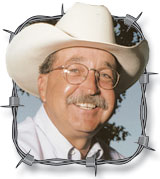Every spring, as I begin to prepare my equipment for the upcoming haying season, I find myself thinking back to my childhood and how harvesting hay is so very different than it used to be.
From my earliest recollection, until I was a teenager, we harvested our alfalfa hay and stored it in a huge barn – in loose form.
After cutting, drying and windrowing the lush forage in the field, Dad would hook up the old, 2-ton truck to a loose-hay loader and have me straddle the windrow. He would then use a pitchfork to distribute the hay from the top of the loader to even layers on the truck bed. I started driving the truck as early as age 6, when my father would set the carburetor to fast-idle, put me on a homemade, wooden box, and instruct me to, “keep that windrow in line with the middle of the hood.”
He’d put it in gear, let out on the clutch, and I would drive until the load was finished, usually having the mound of hay about 4 to 6 feet above the top of the 8-foot-tall, stock racks.
When he would holler that the load was full, I’d jump off my box and push in on the clutch. Now, that was great fun.
As I got older, the fun became much less, once I graduated to the bed of the truck. Then I had to help Dad fork the hay, and pack it around the bed by continually tromping it as I worked. Once the hay was loaded, we still had to unload it with a giant fork, which ran on a track along the entire length of the ridge of barn, then, after it was dumped, redistribute it around the width of the barn.
To this day, I don’t know if I’ve ever worked any harder or in any hotter conditions than handling loose hay on that humid, creek bottom, and inside a barn with no ventilation. It was not fun and when Dad finally parked the old, loose-hay loader and bought his first little square baler, I thought I had died and gone to heaven.
As hard as hauling square bales was, it paled in comparison to loose hay.
Today, with disk mowers, V-rakes, round balers and cab tractors, I can make 10 times the amount of hay in a week, that used to take me all summer. Yet, I get aggravated if I have to get off my air-ride seat and leave the comfort of the air-conditioned cab for more than five minutes.
Last week, while visiting the local feed store, an auction posting caught my eye. It was an estate auction about 40 miles west of my home, scheduled for Saturday. On the poster was a large, full-color picture of a completely restored, loose-hay loader, almost identical to the one that had so traumatized my childhood. Since I had already made plans to attend a cow sale at the same time, I asked a neighbor who was going to the estate sale to, “keep an eye on the loose-hay loader and buy it for me if it brings less than a $100 dollars.”
“What the heck?” he asked, “Are you going to start putting up loose hay?”
“Nope,” I replied. “I’d just like to park it in my front yard as a daily reminder that I never want to work that hard… again… in my life.”







